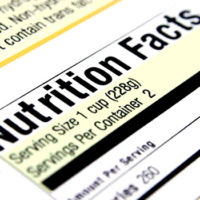Smart Food: Understanding the Nutritional Value of Canned Foods
When it comes to food, consumer tastes may vary, but the qualities they value do not. Freshness, high-quality ingredients, convenience and environmental responsibility invariably find their way to the top of consumer demands for their food products and packaging. The can helps brands achieve all of these, but consumers may not always realize this.
Metal cans have been keeping food fresh for over 200 years, ever since Britain’s King George III granted Peter Durand a patent for his idea of preserving food in airtight tin containers in 1810. By the end of the 20th century, canned fruits, vegetables, meats and meals had become a standard part of our culture, and could be found on almost every household’s shelves. Today, however, while we continue to value canned foods for the convenience they offer, we tend to forget the benefits that drove people like Durand to package foods in metal, namely the health and nutritional advantages that the format affords.
 The Importance of Nutrition
The Importance of Nutrition
The rising rates of obesity in the United States have created an important dialogue surrounding the importance of a nutritious diet. It comes as no surprise that many Americans do not consume the recommended servings of an array of nutritious foods. Notably, the U.S. Department of Agriculture[1] encourages all Americans to increase their intake of fruits and vegetables. Maintaining a healthy diet is a basic human need, and our scientific understanding of the nutritional value of foods continues to grow. A balance of the right proteins, vitamins and minerals is important to repair and sustain our bodies—everything from our muscles to our nervous systems.
As consumers increasingly understand the role that nutritious foods play in maintaining a healthy lifestyle, and as they progressively value more health-conscious diets, they continue to demand brand owners provide the most nutritious food options possible.
Some consumers are of the mindset that canned foods are less nutritious than their fresh or frozen counterparts are. But in fact, nothing could be further from the truth.
Canned foods are nutritionally on par with fresh and frozen products, and in many cases, they are actually more nutritious. According to a 2012 study by Michigan State University,[2] for example, the retort process employed during canning tomatoes actually improves their B vitamins, vitamin E and carotenoid content. Similarly, fiber, a nutrient of concern in the 2010 Dietary Guidelines for Americans, becomes more soluble and therefore more useful in the human body, during canning.
This comes about through the canning process itself, whereby foods are picked at the peak of freshness and immediately transported to the canning facilities, which are strategically located near farms to ensure that fruit and vegetables are canned within hours of being picked. The food is then cooked in the can to destroy bacteria leaving a low-oxygen environment that inhibits degradation of the food and its nutrients during the can’s shelf life.
As a result, food is able to remain stable in a can without the need for any chemical preservatives—an important distinction between canned and fresh foods. Fruit and vegetables begin to lose nutritional value from the first moment they are picked, and canning and freezing facilities are located near farms for that very reason. It can, however, sometimes take weeks to transport fresh produce from the farm to store shelves, during which period many of the valuable nutrients can be lost. For this reason, fresh food is typically treated with preservatives after picking to prevent it from spoiling but also exposing consumers to otherwise unnecessary chemicals. And, in the case of frozen foods, while produce is flash frozen immediately to lock in freshness, brands are then faced with high-energy costs to maintain vegetables in that frozen state during storage and transportation, whereas canned goods can be transported as is.
At the same time, additional studies show[3] that canning increases the availability of certain antioxidants in foods and vegetables. Canned beans are typically low in saturated fat and calories while containing high fiber content, which can reduce the risks of heart disease or diabetes.[4] Canned pumpkin, for example, contains a higher concentration of beta carotene than fresh pumpkin, and the absorption in corn of lutein, an antioxidant that has been linked to a reduction in the risks of cataracts and macular degeneration, is also enhanced by heat from the canning process.[5]
 The Value of Metal Packaging
The Value of Metal Packaging
The high temperatures of retort cooking also effectively sterilize the food products in cans, which is critical to maintaining the safety of those foods. Metal cans protect food against any external influence during heat treatment as well as storage because of the hermetic seal formed prior to retorting. According to the U.S. Centers for Disease Control and Prevention,[6] at least 128,000 Americans are hospitalized each year with foodborne illnesses, and analyses conclude that canned foods are a safer option thanks in part to the canning process that creates a barrier to microbiological contamination.
This is of particular relevance to the canned meat and vegetable industries, where quality and freshness are of top concern. As metal packaging transfers heat during the retort process to the food more rapidly than alternative materials and allows the heat to completely penetrate to the center of the product, the food is completely cooked and preserved without risk of spoiling during storage. This is essentially the exact same process used in home canning, simply on a larger scale—the food, water and any salt or spices for taste are canned, heated and then left to cool. With the Food and Agricultural Organization of the United Nations finding that one-third of the food produced globally for human consumption is discarded and with consumers in North America and Europe wasting around 209 to 253 pounds of food per person every year, canned fruits and vegetables provide a smart shelf-stable option for families and one that offers valuable savings, both reducing the amount of time required to prepare a meal, and also helping families maintain a healthy lifestyle on a tight budget.
Additionally, once the packaging process is complete, it is the metal can that most effectively continues to preserve the quality of the food it contains. Foods typically degrade through extended exposure to air or sunlight, and metal is the only container material that completely prevents light and oxygen from infiltrating the package, offering excellent barrier properties. This is, of course, why products ranging from condensed milk to pet food have traditionally been packaged in metal, as the barrier of the can greatly extends the product’s shelf life.
In addition, the metal can speaks strongly to consumers’ preferences for environmentally friendly choices in every aspect of their lives. Metal is 100% recyclable, recycled at high levels and can be continuously reused with absolutely no degradation in performance or quality. Consequently, cans are currently the most recycled food packages in the world, with 66.8% of steel cans being recycled in the United States alone according to the most recent industry data.[7]
Beyond these inherent benefits, cans are also being found to be beneficial to promoting a healthier lifestyle among consumers. Canned products remain the perfect staple foods to stock up on and have on hand at any time; they are available year round 24/7 and provide an easy means for people to consume the recommended daily amounts and varieties of fruits, vegetables, meats and beans. From ready-meals to sauces, consumers are presented with a variety of products available in cans. Packaging also plays a critical role in limiting portion sizes, as brand owners seek to introduce products that help consumers maintain healthier diets.
Single-serve cans, for example, allow consumers to enjoy portion-controlled meals and healthy snacks straight from the package, in the process saving time and effort associated with preparing a separate dish and cleaning up. For this growing trend, CROWN Food Packaging North America’s single-serve, bowl-shaped cans make it easy to consume healthy packaged foods. Bowls also have a sleek, modern shape that attracts attention on store shelves and helps convey a premium image. When paired with CROWN’s award-winning Easylift™ easy-open ends and PeelSeam™ peelable ends for quick and easy removal, consumers can enjoy their meals without the need for a can opener. In addition to being easy to open, both ends offer the same unrivaled barrier against light, oxygen and water ingress that the cans themselves do, maintaining the flavor and sterility of foods that are consumed without extra preparation.
The result is an extremely convenient packaging format for the consumer, especially when compared to fresh or frozen goods. From vegetables to fruits to meats, once opened, canned foods are ready to eat. This is a fast and easy process compared to fresh produce, which must be cleaned, chopped, prepared, and cooked from a raw state, and similarly compared to frozen foods, which must be thawed out before anything else can be done. Canned foods, in contrast, are available for immediate consumption.
Getting the Most from Metal
As consumers increasingly look for healthy food options on store shelves, it is important for brands to understand how to get the most from metal packaging and to partner with a supplier that has the necessary expertise to properly respond to the market opportunities.
Beyond individual technologies, brand owners also need to collaborate with their suppliers wherever possible, working closely with the technical and customer service teams to get the most out of the processes. Strong customer service teams will understand the entire food manufacturing process and can provide a wide range of valuable assistance, from technical support and troubleshooting to ongoing consultation. For example, brand owners that package products in cans need to understand double seaming, which is vital to container integrity and ensuring that food products are properly preserved, and suppliers should be offering regular training in this area. To meet this need, CROWN provides double-seam guidelines and training that are used as a reference by the U.S. Food and Drug Administration, and can be shown to customers’ auditors and any other authorities that examine their facilities.
Customer service teams should also be available to troubleshoot any issues that brands may encounter during the production cycle, helping to identify and recommend solutions to any problems. CROWN’s teams consist of food scientists, design engineers, chemical engineers and even microbiologists, all of whom have a deep understanding of food processing and the packaging industry. This allows brand owners to be confident that their production lines are optimized and that the final canned food is healthy and nutritious.
Despite misconceptions in the market, foods packaged in metal cans—from vegetables to pet food—are recognized by the industry and relevant bodies as the nutritious and healthy choice. In many cases, they have been proven more nutritious than their fresh or frozen counterparts. Understanding how to leverage the inherent benefits of metal packaging to provide nutritional foods for today’s health-conscious consumers is of key importance for companies seeking to provide healthy options for their food brands.
Hella Gourven is the marketing manager at CROWN Food Packaging North America, a subsidiary of Crown Holdings, Inc., a supplier of packaging products to consumer marketing companies around the world. Its world headquarters are located in Philadelphia, PA. For more information, visit www.crowncork.com.
References
1. www.cnpp.usda.gov/Publications/DietaryGuidelines/2010/PolicyDoc/Chapter4.pdf
2. www.cancentral.com/files/CMI_MSU_Study_Release.pdf
3. www.cancentral.com/pdf/SteelCanFoodFacts.pdf
4. www.livestrong.com/article/546871-the-healthiest-canned-beans-with-high-fiber
5. www.ncbi.nlm.nih.gov/pubmed/17846363
6. www.cdc.gov/media/pressrel/2010/r101215.html
7. 2009 data; Source: Steel Recycling Institute
Looking for a reprint of this article?
From high-res PDFs to custom plaques, order your copy today!





